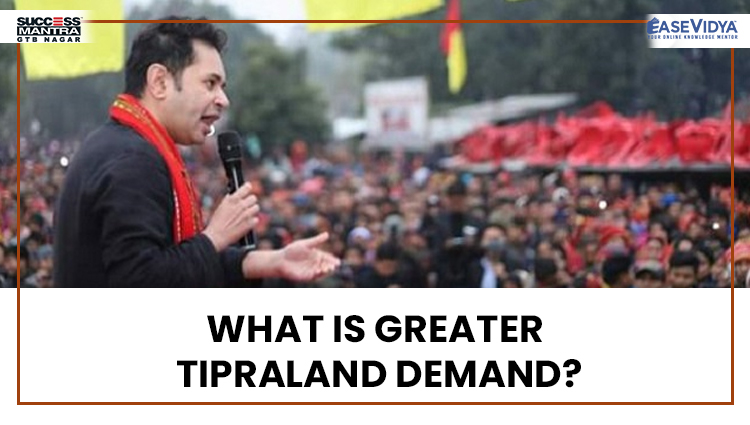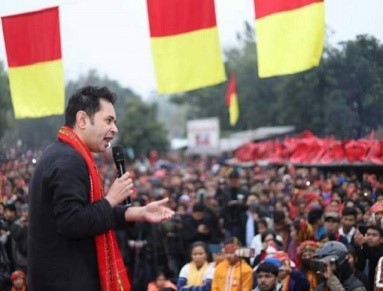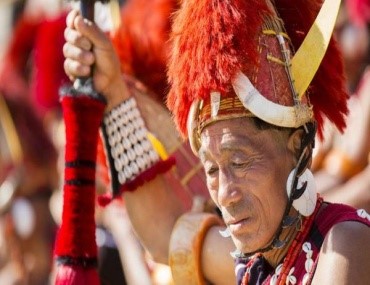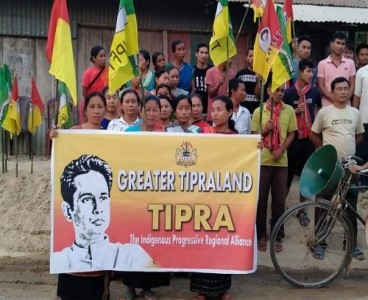
WHAT IS GREATER TIPRALAND DEMAND?
WHAT IS GREATER TIPRALAND DEMAND?
Recently, several tribal outfits in Tripura have joined hands to push their demand for a separate state, Greater Tipraland for indigenous communities in the region. Among the political parties that have come together for the cause are TIPRA Motha Tipraha Indigenous Progressive Regional Alliance) and IPFT (Indigenous People’s Front of Tripura).

Current Affairs Notes By Success Mantra Coaching Institute GTB Nagar Delhi CLICK HERE
WHAT IS GREATER TIPRALAND?
Greater Tipraland is the extension of the Indigenous People's Front of Tripura's demand of Tipraland as a separate state for tribals. This demand is said to involve each tribe residing in the indigenous area or village outside the Tripura Tribal Areas Autonomous District Council. This model is not restricted to Tripura Tribal Council Areas but also seeks to include Tiprasa of the Tripuris that are spread across Mizoram and Assam, Bandarban, Chittagong, Khagrachari too. The demand would be placed in front of the Central Government in case the leaders are invited for talks. The demand for Greater Tipraland rose as the demands for revising the NRC in Tripra were unfulfilled.
ARTICLE 2 & 3 OF THE INDIAN CONSTITUTION
- Article 2: Parliament may by law admit into the Union, or establish, new States on such terms and conditions as it thinks fit.
- However, Parliament cannot establish a new union territory by passing a law that can only be done through a constitutional amendment. States like Sikkim (previously not within India) became a part of the country under Article 2.
- Article 3: It empowered the Parliament to make law relating to the formation of new states and alteration of existing states.
- Immediate Cause: The churn in the state’s politics with the rise of TIPRA Motha and the Assembly polls due in early 2023 are the two major reasons behind the development.
Historical Background: Tripura was a kingdom ruled by the Manikya dynasty from the late 13th century until the signing of the Instrument of Accession with the Indian government in 1949. The demand stems from the anxiety of the indigenous communities in connection with the change in the demographics of the state, which has reduced them to a minority. It happened due to the displacement of Bengalis from the erstwhile East Pakistan between 1947 and 1971. From 63.77% in 1881, the population of the tribals in Tripura was down to 31.80% by 2011. In the intervening decades, ethnic conflict and insurgency gripped the state, which shares a nearly 860-km long boundary with Bangladesh. The joint forum has also pointed out that the indigenous people have not only been reduced to a minority, but have also been dislodged from land reserved for them by the penultimate king of the Manikya dynasty Bir Bikram Kishore Debbarman.
PRAVAHINI Current Affairs Notes By Success Mantra Coaching Institute GTB Nagar Delhi CLICK HERE
SIMILARITY TO GREATER NAGALIM?
As per Pradyot Kishore the demand for Tipraland is a democratic issue and the demand of Greater Nagalim. The Greater Nagalim idea was floated by the rebel Naga agency- NSCN (IM). It is now involved in peace talks with the central government. The new demand seeks to include every tribal person living in indigenous area or village or village outside the Tripura Tribal Areas Autonomous District Council (TTAADC) under the proposed model.
Facts about Tripura:
- The Tripuri are also called Tipra, Tiprasa, Twipra etc and are an ethnic group that originated in Tripura
- They are basically inhabitants of Twipra, North-East India and Bangladesh
- They ruled through the Manikya dynasty until 1949
- Their main dialect is Konborok, also called Tiprakok or Tripuri
Political Standing of the issue: TIPRA has emerged as the single-largest political party of Tripura, with Pradyot's new political maneuvering. The royal scion has also announced an alliance with all major tribal political parties where two parties majorly are Tipraland State Party and Indigenous Peoples Front of Tripura. The ‘Greater Tipraland’ is said to be in consonance with the demand of ‘Tipraland’ which is a proposed separate state for tribals of Tripura. This idea was floated in 2009 and also was the main poll agenda which led to the victory in the 2018 assembly election. The oldest tribal party has also joined the cause and has supported TIPRA. It said that while Tipraland was only restricted to ADC, Greater Tipraland would be a better extension to it.

What is Tipraland?
The formation of Tipraland which is a state within the Tripura Tribal Areas, is a political agenda. It is to be formed under articles 2 and 3 of the Indian Constitution and has been demanded by a political party called the Indigenous People's Front of Tripura (IPFT). Take a look at the map below.
INITIATIVES TO ADDRESS THE ISSUE
Tripura Tribal Areas Autonomous District Council: The Tripura Tribal Areas Autonomous District Council (TTAADC) was formed under the sixth schedule of the Constitution in 1985 to ensure development and secure the rights and cultural heritage of the tribal communities. ‘Greater Tipraland’ envisages a situation in which the entire TTAADC area will be a separate state. It also proposes dedicated bodies to secure the rights of the Tripuris and other aboriginal communities living outside Tripura. The TTAADC, which has legislative and executive powers, covers nearly two-third of the state’s geographical area. The council comprises 30 members of which 28 are elected while two are nominated by the Governor.
Reservation: Also, out of the 60 Assembly seats in the state, 20 are reserved for Scheduled Tribes.
Other Demands in the North East
- Greater nagalim (Parts of Arunachal Pradesh, Manipur, Assam and Myanmar)
- Bodoland (Assam)
- Tribal Autonomy Meghalaya

CONCLUSION
Economic and social viability rather than political considerations must be given primacy. There should be certain clear-cut parameters and safeguards to check the unfettered demands. It is better to allow democratic concerns like development, decentralization and governance rather than religion, caste, language or dialect to be the valid bases for conceding the demands for a new state. Apart from this the fundamental problems of development and governance deficit such as concentration of power, corruption, administrative inefficiency etc must be addressed.
TEST YOURSELF
Q.1 Which of the following schedules of the Indian Constitution deals with the administration of the tribal areas in the four northeastern states of Assam, Meghalaya, Tripura and Mizoram as per article 244?
- Fourth Schedule
- Fifth Schedule
- Sixth Schedule: ANSWER
- None of the above
Q.2 Which of the following statements is/are incorrect in the reference to the 'Greater Tipraland' demand?
- It is an extension of the ruling Indigenous Peoples Front of Tripura's (IPFT) demand of Tipraland, which seeks to form a separate state for tribals of Tripura.
- Tripura royal scion Pradyot Kishore Manikya who put forward the demand was the state President of the BJP: ANSWER
- It also includes ‘Tiprasa’ of Tripuris spread across different states of India like Assam, Mizoram and even those living in areas bordering Bangladesh.
- None of the above
Q.3 The 'territory of India' is considered as having a wider scope than the 'Union of India' as it includes which of the following?
- The territories of the states
- The Union territories
- Any territory that may be acquired in future
- I & II follows
- I & III follows
- I, II & III follows: ANSWER
- None of the above
Q.4 Consider the following and state which of the following is/are correct in the reference to the above mentioned passage?
- Since formation of new states under Article 3 involves changing the First and Fourth Schedule, it needs the special majority in both houses of Parliament.
- Article 3 allows admission or establishment of new states that are not part of the Union of India: ANSWER
- India has not acquired foreign territories since independence.
- None of the following
Q.5 Which of the following given statements is/are incorrect in the context of the admissibility or the formation/establishment of the new states?
- Article 4 relates to the admission or establishment of new states that are not part of the Union of India.
- Being a sovereign state, India can acquire foreign territories as per the modes recognized by international law, i.e., cession.
- The union territories and the acquired territories are administered by the Central as well as the State Government.
- I & II follows
- II & III follows
- I & III follows: ANSWER
- None of the above













0 Comment